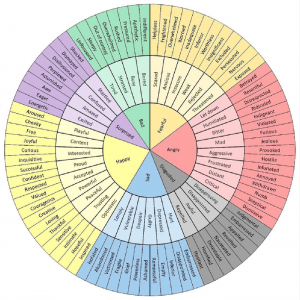Whether it’s a video or a sales proposal for your dream customer, all effective marketing and sales are powered by one straightforward idea: people are driven by emotion when they make buying decisions.
If you doubt this, think about the last major purchase you made. You probably recall it as a reasonable and logical process: You asked friends for recommendations, watched youtube videos, or talked to a salesperson about that laptop or new car you were considering.
But think on it a bit, and you’ll start to notice some emotional undercurrents. And for every seeming logical consideration, there were many feelings and emotional factors.
This topic can get very deep very quickly. For example, here’s a breakdown of something called the Emotion Wheel. It’s an eyeful.
But let’s just take that new car example and explore what appears to be a perfectly logical concern.
How much will it cost?
The biggie. The one you can’t wait to ask—the one the car salesman will forego answering as long as possible.
But the answer is much more than just a number, and behind it is several emotional concerns. Things like:
Fear: Will I regret paying too much?
Pride: Is it nice enough to pull up in on my next date?
Trust: Is this salesperson honest?
“How much?” seems like such a simple question. But a good marketer or salesperson sees it as a conversation starter for uncovering a much bigger picture: the hidden fears behind the question.
Unmask the hidden emotions of effective marketing and sales
The surprising fact is that our emotions aren’t just hidden from others; they’re often hidden from ourselves. So good marketers and sales professionals familiarize themselves with their customer’s positive and negative emotional drivers and address these emotions with their content.
It’s not so much about becoming psychoanalysts as it is becoming curious. So first, make sure you have answers to the most basic questions such as:
What does the customer want?
What will it do for them?
How best to provide it?
Once you know the basics, the next step is to ask about their concerns in these areas. This may be more difficult on the front end of the sales process, but asking for testimonials will allow you to explore. For example, ask what hesitancy they had before choosing your product or service.
Surveys provide another opportunity to ferret out emotions such as hope, fear, and frustration. Finally, ask for negative and positive feedback regarding your current buying process.
Appealing to emotion is not manipulative
There’s nothing manipulative about helping customers get what they want, clarifying what it will do for them, and providing it accordingly. But, to do so, you have to address the emotional element.
We account for the emotions of friends and family; why not do it for our customers?
It simply a fact: humans are driven by feelings. So incorporating this fact into your marketing strategy just makes good sense.
Do it well, and you’ll appeal to the most essential marketing and sales emotion of them all: trust.


